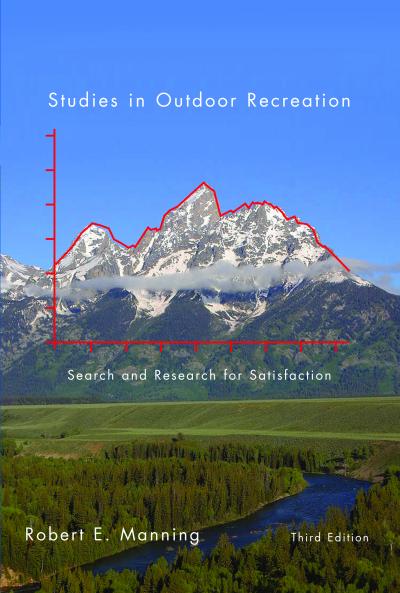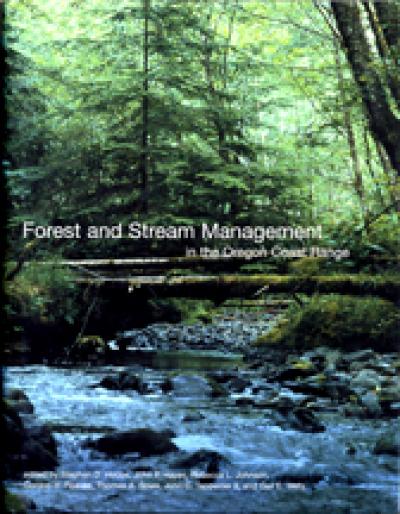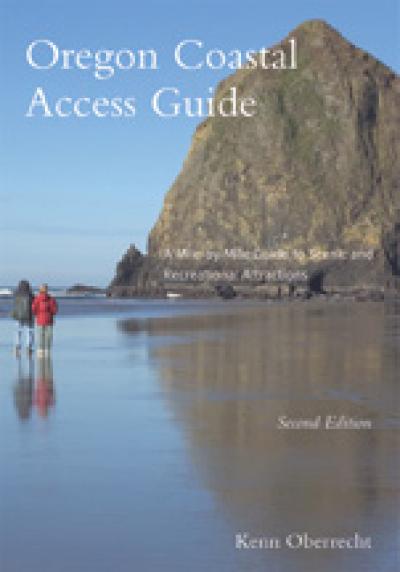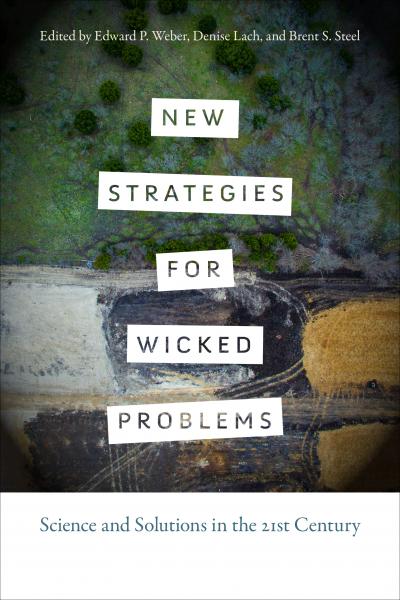
Carrying Capacity in Recreation Settings
Thomas A. Heberlein and Bo Shelby
One of the most difficult questions facing researchers and managers in recreation resource management is how to determine the optimum carrying capacity of a given recreation site--how many people is too many? And this is a question that is becoming increasingly urgent as increasing resource use produces more problems of crowding and overuse. In this context, effective management becomes increasingly important. But truly effective management must rely on the provision of relevant data and practical models from researchers.
Carrying Capacity in Recreation Settings applies research to management by using hard data to solve real problems. The authors note the shortcomings of previous attempts to solve the problem of carrying capacity, and give details of their own method of doing so, illustrated with real-life applications in diverse recreation settings. The model developed here has been used by state and federal agencies to estimate carrying capacities for the Grand Canyon and other areas, and it has already become a basic theoretical approach for research in the field.
Carrying Capacity in Recreation Settings is an essential tool for all researchers, resource managers, and advanced students.
About the author
Thomas A. Heberlein is a Professor in the Departments of Rural Sociology and Sociology at the University of Wisconsin-Madison. He has published extensively in the field of carrying capacity studies, as well as participating in research, and acting as a consultant both to professional journals and to such organizations as the National Park Service.
Read more about this author
Bo Shelby is an Associate Professor in the Department of Resource Recreation Management at Oregon State University. He has published extensively in the field of carrying capacity studies, as well as participating in research, and acting as a consultant both to professional journals and to such organizations as the National Park Service.
Read more about this author
Introduction
1. Recreational Carrying Capacity
2. Describing Recreation Use
3. Evaluating Use: Satisfaction
4. Evaluating Use: Feeling Crowded
5. Evaluating Use: Contact Preference Standards
6. Moving Ahead with Carrying Capacity Research
7. The Next Step: Allocating Use
Appendix 1. Measurement for Capacity Studies
Appendix 2. Setting up Carrying Capacity Studies
Appendix 3. Data Describing Allocation Systems
Bibliography
Index
Floating through Grand Canyon on the Colorado River is a spectacular adventure. John Wesley Powell made the first expedition through the Canyon in 1869, but even as recently as 1950, fewer than 100 people had run this section of the Colorado River. In the 1960s all that changed. visitor numbers increased an average of 59% per year between 1960 and 1972, from 547 floaters in 1966 to 16, 248 in 1972. Crowding and overuse problems were particularly evident to boatmen and outfitters who had run the river in earlier years. A petition submitted to the Park Service put it this way: " A Colorado River trip gives people a chance to experience the beautiful, quiet, and sublime wonders of the Grand Canyon. Let them stand alone under the great waterfall at Deer Creek and feel its power, without hundreds of people pushing, taking pictures, bathing, and filling water jugs. The Canyon should provide a contrast to the cities, with their problems of overpopulation and crowding." Complaints such as these caused the Park Service to freeze use at 1972 levels, pending studies of carrying capacity.
Crowding and overuse problems in Grand Canyon were not unique (Hendee et al. 1978). In Yosemite national park, backcountry camping increased from 78,000 to 221,000 overnight visits between 1967 and 1972. Between 1967 and 1974, overnight stays in Shenandoah National Park quadrupled. In the 10-year period from 1966 to 1976, backcountry use in Rocky Mountain National Park increased 730%, while overall use of the park increased only 73%.
Use figures for National Forest backcountry areas show similar trends. From 1946 to 1964, visits to wilderness areas increased about sevenfold, while population of the United States increased only 35%. Visits nearly doubled from 1965 to 1975, while population grew about 10%.
In response to this dramatic growth in backcountry use, many studies have described and evaluated recreation impacts. Much of this research fits under the generic label "carrying capacity" and is concerned with determining the number of users that can be accommodated by a given area without loss in the quality of the natural environment and/or the visitor experience. Scientific investigations have documented recreation impacts and factors affecting their incidence and severity. In addition, popular articles have conveyed this knowledge to the general public, and articles for recreation managers have attempted to provide a framework and/or guidelines for application of this understanding to the planning and management of recreation resources.
Concerns about crowding and resource deterioration in recreation settings can be traced to the late 1920s (Meinecke 1928). J.V.K. Wagar (1946) and the ORRRC reports (1962) provided further support for the importance of the carrying capacity concept, but major theoretical and empirical advances did not appear until 1964. At this time researchers in the USDA Forest Service (Lucas 1964; J.A. Wagar 1964) pioneered what would become a major effort to consider the impacts associated with the presence of varying numbers of recreationists.
The Forest Service's early attention to recreation impact problems stems partially from two conflicting legislative acts. The Multiple Use and Sustained Yield Act of 1960 and the Wilderness Act of 1964 mandated the agency to provide recreation opportunities but also to conserve the natural characteristics of selected environments. The early presence of the Forest Service in this field can also be attributed to the existence of previously established experiment stations through out the nation. Because these stations had the human and financial resources, a publication outlet for technical reports, and the official mandate to conserve natural areas, the agency was well positioned to become a leader in research activities.
The frequently cited early papers that came out of the Forest Service (e.g. Lucas 1964, Wagar 1964, Hendee et al. 1968, Stankey 1971, 1973) served several functions. First, they began the process of documenting the social consequences of the presence of other visitors on a recreation experience. Second, the mere existence of these reports brought to light similar issues faced by other agencies. Cahn (1968) and others, for example, began to question whether success would spoil the National Parks. The Conservation Foundation (1972) also published several recommendations aimed at restoring the mission of the Park Service as steward of special and unique environments.
A third function served by these early articles was to legitimize the study of social issues in a natural resource setting. Prior to the late 1960s and early 1970s, university-based programs or departments concerned with environmental issues tended to focus on biological considerations. Similarly, recreation departments housed in colleges of physical education, recreation, and health were primarily concerned with activity programming, administration, and therapeutic recreation.
Since the late 1970s, however, many major universities and colleges have had at least one researcher interested in evaluating recreation impacts from a social science perspective. Associated with this growing interest in understanding the human aspects of outdoor recreation has been an increase in the number of publication outlets. In addition to the general technical reports produced by government agencies, university-based experiment stations, and private organizations, a number of technical journals now regularly include articles on the social dimensions of outdoor recreation. These include Leisure Sciences, Journal of Leisure Research, Journal of Applied Ecology, Journal of Forest, Journal of Soil and Water Conservation, Wildlife society Bulletin, Environmental Economics and Management, Environmental Management, and Journal of Interpretation. Similarly, specialized conferences have emerged, some with their own yearly proceedings (e.g. the Southeastern Recreation Researchers' Conference, Wilderness Psychology Group, Rural Sociological Society, etc.). This list is by no means exhaustive, but it illustrates the breadth and diversity of interest groups now actively engaged in recreation research.
Since the early Forest Service studies, numerous researchers have sought to establish carrying capacities for specific resources (see, for, example, Vaske et al. 1984); proposed guidelines for sorting out the complexities of the concept (Brown 1977, Hendee et al. 1978, Schreyer 1976, Shelby and Heberlein 1984, Stankey 1979); and even questioned the validity of the carrying capacity concept for recreation (Bury 1976, Burch 1981, 1984, Washburn 1982, Becker et al. 1984). Efforts to pull together and synthesize previous work related to carrying capacity and visitor impacts have resulted in several annotated bibliographies that have examined particular related topics, such as Cole and Schreiner's (1981) bibliography on soil and vegetation impacts, Ream's (1980) bibliography dealing with the impacts of recreation on wildlife, and Stankey and Lime's (1973) annotated bibliography on several recreational carrying capacity considerations. Most recently, a bibliography by Vaske et al. (1984) identified over 2,000 published and unpublished articles on human impacts in natural environments. In spite of the volume of research that has been conducted however, "social carrying capacity remains an elusive concept" (Graefe et al 1984b). Stankey 1980:6) states that "significant conceptual and methodological problems remain." while Burch (1981:221) goes further in suggesting that "research methodology, theory, and findings remain at a primitive level."
There is no shortage of models in the recreational carrying capacity literature. Hendee et al. (1978:169), for example, describe a "general model of carrying capacity" and its possible application to wilderness. This model deals with ecological and social impacts of increasing wilderness use, and considers management objectives and value judgments. Lime (1976:123) points out that carrying capacity has traditionally been "a management concept, a framework or way of thinking about how to plan and manage a particular recreation resource. It is not the basis for some magic formula that gives the manager the answer to the continuing question how much is too much." because of the difficulty of making a model operational and actually helping managers make capacity decisions, some researchers (Wagar 1974, and Bury 1976) have argued against the carrying capacity concept to illustrate how a carrying capacity model works. Hendee et al. (1978) are forced to use a plausible but hypothetical example at the close of their chapter on carrying capacity.
The models proposed by Hendee et al. (1978) and others (Washburn 1982, Graefe et al. 1984a) are useful ways of thinking about the carrying capacity issue. But moving from theoretical discussions to management applications requires an operational set of procedures to arrive at a specific number. The goal of this book is to integrate theory and application by developing the procedures which appear to be most useful.
Our involvement in carrying capacity research began in 1973 when we were involved in the National Park Service project to determine carrying capacity for river running on the Colorado River in Grand Canyon National Park. Since that time, we have done carrying capacity studies involving a diversity of activities and settings. These include river running in wilderness areas, river running and tubing in developed areas, river running in a sensitive bald eagle habitat, wilderness backpacking, hiking in more developed areas, deer hunting in remote areas, deer hunting in intensively managed experimental areas, goose hunting in high density "firing lines," goose hunting in low density "managed hunts," fishing in several areas, and sailing in the marinas and islands of Lake Superior. Although we come from an academic background and share a commitment to scientific research all these projects were done at the request of resource managers who needed to solve immediate and pressing overuse problems.
We believe the relationship between theory and application is truly symbiotic. Science is advanced when researcher take responsibility for working through application of theory, and management improves when managers discover the ways research an work for them. This book, therefore, speaks to both researchers and managers.
The model presented in this book is a practical, applied approach to social carrying capacity which builds on the existing literature as well as our own research. This approach usually provides numerical capacity estimates, and when it does not the exact reasons are clear. There is little in our model which is inconsistent with prior thinking in the field. Its principal contributions are to: (1) organize and make explicit a set of, concepts, variables, and procedures for establishing carrying capacity; (2) demonstrate the utility of the sociological concept of norms as an explicit means of measuring visitor preferences; and (3) provide empirical evidence regarding the evaluative dimension of carrying capacity.
There are at least three difficulties in establishing capacities. First, people have different wants, so there are different carrying capacities for different experiences (Schreyer 1976). Second, any use produces some change, and it is difficult to tell just how much change is too much (Hendee et al. 1978). Finally, the number of users is sometimes a poor predictor of impact; even low amounts of use, for example, can severely impact plant communities (Cole 1982). The approach developed in this book deals with each of these difficulties it provides an empirical method for identifying specific recreation experiences, and indicates the data needed to determine appropriate numbers of people for different types of experiences. By focusing on areas where people agree rather than disagree, it is often possible to establish capacities for specific experiences. The model also specifies the data needed to show whether the number of users in the system is related to impact.
As capacity studies move away from theoretical discussions toward actual applications (see, for example, McLaughlin et al. 1982), the model presented in this books is a first step. It does not cover all the issues or answer all the questions, but it does give a common framework and shows how a model can be applied.
Book Overview
This book develops a general conceptual framework for carrying capacity which can be applied to a variety of situations. The book speaks to researchers who conduct capacity studies and resource managers who make capacity decisions. although we think this approach combines the best of science and management, certain sections may be of greater interest to one group or the other. Each chapter has a summary at the beginning for those who want only a brief overview.
Chapter 1 looks at some of the issues in nonhuman capacity research, reviews the relevant carrying capacity literature, and develops a framework for social carrying capacity in recreation settings. We have not tried to review all the prior literature, but have highlighted the material that serves as the basis for our approach.
Chapter 2 describes the areas we studied and the recreation experiences they offer. It then presents the descriptive component of these capacity studies, which defines use patterns and the relationships between management parameters and impact parameters.
Chapters 3 and 4 explore crowding and satisfaction, drawing on theoretical issues and quantitative evidence. From the manager's point of view, the bottom line is that we find perceived crowding and overall satisfaction have only limited usefulness for determining social carrying capacity. If you want to know why, look at these chapters; if not, go on to Chapter 5.
Chapter 5 describes the approach we have found most useful for making capacity judgments. There are some complications and qualifications, of course, but with the right information capacity can often be estimated. This chapter reports three case studies where efforts to establish capacity met with varying degrees of success.
Chapter 6 deals with implementation, application, and future research. The gathering of data alone does not guarantee that a carrying capacity will be set; the first section of the chapter identifies the issues that will help both managers and researchers decide whether a study is likely to be translated into policy. The next section shows how to apply the model to new activities and areas, and the chapter concludes with a brief discussion of issues which warrant further research.
Chapter 7 discusses the allocation issue. Solving one problem sometimes creates others, and this is true with carrying capacity. Setting a use limit establishes the size of the pie, so to speak, but then people start fighting about who gets the biggest piece. All allocation systems require tough decisions about goals and objectives. Two basic allocation mechanisms are described and their benefits in specific situations evaluated.
For those planning to become involved in a carrying capacity study, three methodological appendices are included. The first reports the measures used in our carrying capacity studies, the second deals with the broader issues which must be considered in setting up a capacity study, and the third outlines the data which are useful for making allocation decisions.




